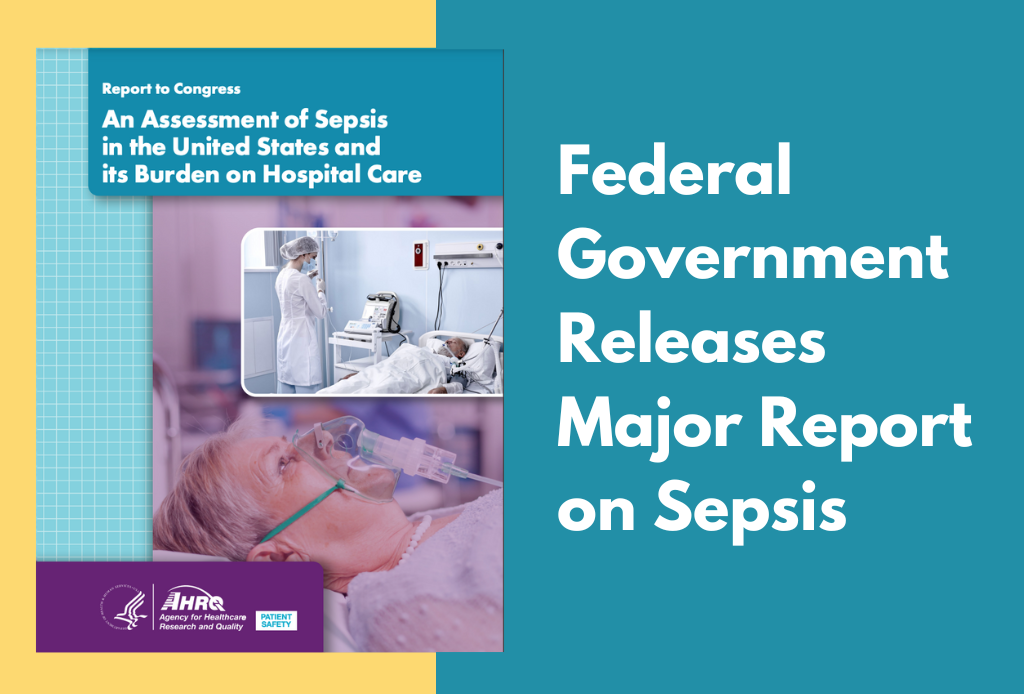
Last month, the Agency for Healthcare Research and Quality (AHRQ) released its long-awaited Congressional Report on sepsis. As part of the 2023 Appropriations Act, AHRQ was directed to conduct a comprehensive set of studies that calculate the morbidity, hospital readmissions, and mortality related to sepsis. The allocation of funds to AHRQ for this purpose was requested by END SEPSIS.
The report offers the most comprehensive assessment of hospital use related to sepsis and its burden on the hospital system ever published in the United States. It identifies a massive increase in hospitalizations and disparities in hospitalization and mortality amongst different subpopulations and geographic locations.
The report’s authors conclude that targeted initiatives are necessary to improve patient outcomes and reduce financial strain on healthcare institutions, international guidelines for sepsis recognition and management and quality improvement initiatives must be updated and refined and that continued investments in sepsis surveillance and quality improvement systems must be made at the by Federal, State, and nongovernmental entities.
The report is an invaluable asset in the fight to focus attention and resources on sepsis. We thank the many researchers involved for their excellent and timely contributions. Read the report.
Read AHRQ’s Blog Post Following the Release of the Congressional Report.
The human suffering caused by sepsis is shocking. New AHRQ analyses show that in 2021, more than 2 million Americans—roughly equivalent to the population of Phoenix, Arizona—were hospitalized with sepsis, 300,000 lives were lost, and hospital costs exceeded $52 billion.
Sepsis is an extreme reaction to an untreated infection, causing the body to attack itself, leading to tissue damage, organ failure, and often death. Anyone can develop sepsis, though older adults and individuals with weakened immune systems or conditions like cancer, chronic lung disease, and heart failure are especially vulnerable. Those who survive often require home healthcare, long-term care, or skilled nursing care.
Timing is critical in the battle against sepsis. Quick diagnosis and early treatment are crucial to minimizing its devastating effects. However, gaps in information based on robust data limit our knowledge and present obstacles to policymakers eager to ease the burden of sepsis on our healthcare systems.
To address these needs, in 2023, Congress directed AHRQ to calculate the morbidity, mortality, and costs related to sepsis for all patients, including children and pregnant women. An important part of the project was assessing the contribution of pandemic COVID-19 infections to the burden of sepsis in hospitals.
In recognition of Sepsis Awareness Month, AHRQ released An Assessment of Sepsis in the United States and Its Burden on Hospital Care, a comprehensive federal report on sepsis hospitalizations based on inpatient and emergency department data from partners in the agency’s Healthcare Cost and Utilization Project (HCUP). AHRQ also published four complementary statistical briefs that offer valuable insights on sepsis trends from 2016 to 2021. These analyses paint a dire picture:
- Sepsis is the most common reason for hospitalizations after births, with 2.5 million inpatient stays in 2021. The number of sepsis hospitalizations is growing—with a 40 percent increase between 2016 and 2021. COVID-19 infections contributed significantly to this dramatic rise.
- Hospital costs for sepsis patients soared from $31.2 billion in 2016 to $52.1 billion in 2021, accounting for over 14 percent of all hospital costs. Almost three-quarters of the hospital costs—more than $37.9 billion—were billed to Medicare and Medicaid for sepsis stays.
- Over half of sepsis hospitalizations—1.4 million—were for adults 65 years and older. One in six older patients with sepsis died in the hospital in 2021.
- In 2021, approximately 8,000 pregnant women were hospitalized with sepsis, and 1 in 25 pregnant women hospitalized with sepsis died in the hospital.
- In 2021, there were over 69,000 sepsis hospitalizations for children, and more than 850 children with sepsis died in the hospital.
As is true in many areas of healthcare, disparities exist in sepsis hospitalizations and complications. Non-White patients and patients from more vulnerable communities died more often, had higher hospital costs, and were in the hospital longer than their counterparts.
Steps can be taken to understand and treat sepsis better, and representatives from all healthcare sectors must join the effort. Clinicians must be proficient in current standards of sepsis care, including early recognition and treatment. Healthcare systems need to devote adequate resources to support these efforts, such as utilizing rapid response systems or tools to reduce missed or delayed diagnoses. The Hospital Sepsis Program Core Elements, developed by the Centers for Disease Control and Prevention, can help guide these efforts. AHRQ also offers several resources to confront sepsis’s challenges, including Best Practices in the Diagnosis and Treatment of Sepsis.
Federal, state, and nongovernmental organizations, such as the Surviving Sepsis Campaign, End Sepsis, Sepsis Alliance, and the American Hospital Association, are working to bolster the use of evidence-based practices to reduce sepsis’ burdens, and help patients and families recognize the early signs of sepsis, leading to more rapid evaluation and treatment. But more is needed.
Additional research investments must examine the burden of sepsis in acute and post acute-care settings. We must gain a greater understanding of the root causes of sepsis and the long-term human and financial impacts on patients and families, its stresses on the healthcare workforce and healthcare systems, and the tremendous costs borne by payers, including the outsized burden on Medicare. We need a greater understanding of the effectiveness of systems currently implemented in healthcare settings to aid early detection and care, including artificial intelligence and other digital healthcare solutions.
We must all work together to raise awareness and give a call to action across the healthcare ecosystem to seek ways to mitigate sepsis’s devastating impact.
Dr. Valdez is director of AHRQ. Dr. Owens is the healthcare data and analytics division director in AHRQ’s Center for Quality Improvement and Patient Safety.

